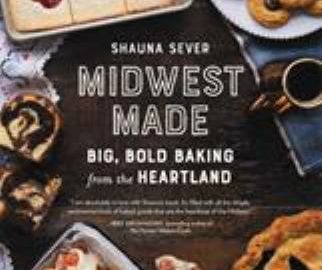
Bibliobites in December: Midwest Meh
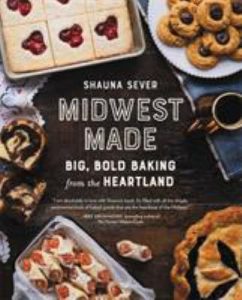 Often the culinary world seems to be neatly divided between those who love to cook, and those who have a passion for baking. Those on the savory side appreciate the more-improvisational nature of cooking– the freedom to alter on the fly and go where whim and ingredients take them. For those with this view, baking is simply too fussy and time consuming; or they (inexplicably) don’t care about sweets. Bakers, on the other hand, are calmed by the precise nature of measuring or weighing, and enjoy combining that classic quartet of flour, sugar, butter, and eggs in infinite ways. In December, our Bibliobites group tackled Midwest Made by Shauna Sever, a baking book focused on (as the subtitle says), big, bold baking from the heartland. Though this book features some savory bakes, it’s mostly about the sugar. And, as it turns out, nearly all in our group consider themselves cooks rather than bakers, so how did it all go down?
Often the culinary world seems to be neatly divided between those who love to cook, and those who have a passion for baking. Those on the savory side appreciate the more-improvisational nature of cooking– the freedom to alter on the fly and go where whim and ingredients take them. For those with this view, baking is simply too fussy and time consuming; or they (inexplicably) don’t care about sweets. Bakers, on the other hand, are calmed by the precise nature of measuring or weighing, and enjoy combining that classic quartet of flour, sugar, butter, and eggs in infinite ways. In December, our Bibliobites group tackled Midwest Made by Shauna Sever, a baking book focused on (as the subtitle says), big, bold baking from the heartland. Though this book features some savory bakes, it’s mostly about the sugar. And, as it turns out, nearly all in our group consider themselves cooks rather than bakers, so how did it all go down?
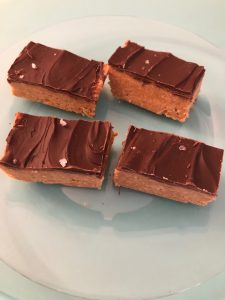 Let’s start with the good news: buckeye bars were an easy no-bake treat with the classic combination of peanut butter and chocolate. They were rich and fudgy, “almost like peanut butter fudge.” Peanut butter was also a hit in the scotch-a-roos, a riff on rice krispie treats; “I have already made three batches!” Sounds like a keeper. White fruitcake was likewise a twist on a classic, if much-maligned cake; it was lightened with meringue and “turned out exactly as the picture in the book…I will be using it as my Christmas cake from now on.” Though it wasn’t zucchini season anymore, double chocolate zucchini loaf was “the best” use of this abundant vegetable. It had good dark chocolate flavor, was moist and kept well. Donut loaf was an intriguing idea– a loaf cake that the recipe claimed would taste just like a powdered sugar donut– and it did! If you are a donut fan this is a delicious and easy way to get your fix. Even better, it uses ingredients you’re likely to have in the house. Jammy fruit and browned butter bars were a hit and a miss: one person thought this combo of fruit and crumbly topping was just right, but another found the crust and topping to be “quite dense.” Unadorned
Let’s start with the good news: buckeye bars were an easy no-bake treat with the classic combination of peanut butter and chocolate. They were rich and fudgy, “almost like peanut butter fudge.” Peanut butter was also a hit in the scotch-a-roos, a riff on rice krispie treats; “I have already made three batches!” Sounds like a keeper. White fruitcake was likewise a twist on a classic, if much-maligned cake; it was lightened with meringue and “turned out exactly as the picture in the book…I will be using it as my Christmas cake from now on.” Though it wasn’t zucchini season anymore, double chocolate zucchini loaf was “the best” use of this abundant vegetable. It had good dark chocolate flavor, was moist and kept well. Donut loaf was an intriguing idea– a loaf cake that the recipe claimed would taste just like a powdered sugar donut– and it did! If you are a donut fan this is a delicious and easy way to get your fix. Even better, it uses ingredients you’re likely to have in the house. Jammy fruit and browned butter bars were a hit and a miss: one person thought this combo of fruit and crumbly topping was just right, but another found the crust and topping to be “quite dense.” Unadorned 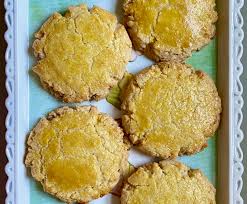 golden almond cookies were a pleasant, not-too-sweet cookie with assertive almond flavor, but the beaten egg yolk brushed on top before baking was too thick– it would have been better had the recipe instructed you to dilute the yolk with water before using. Simple bran muffins were straightforward, but you had to buy bran flake cereal to make them; they were “just OK– but I prefer my go-to recipe that features molasses.” Didn’t know bran muffins without molasses even existed! And one big flop was the crispy iced oatmeal flats which “tasted like cardboard.” ‘Nuff said!
golden almond cookies were a pleasant, not-too-sweet cookie with assertive almond flavor, but the beaten egg yolk brushed on top before baking was too thick– it would have been better had the recipe instructed you to dilute the yolk with water before using. Simple bran muffins were straightforward, but you had to buy bran flake cereal to make them; they were “just OK– but I prefer my go-to recipe that features molasses.” Didn’t know bran muffins without molasses even existed! And one big flop was the crispy iced oatmeal flats which “tasted like cardboard.” ‘Nuff said!
There is a chapter titled “Savories,” and some of our avowed non-bakers focused on that. Nebraskan runzas were a filled bun; the filling of ground beef, cheese, and cabbage was a yummy complement to the soft yeasted dough surrounding it. These were a bit fussy to make but worth the effort (and the recipe makes 12!). English muffin bread looked just like its picture; it had the requisite holes and made excellent toast. 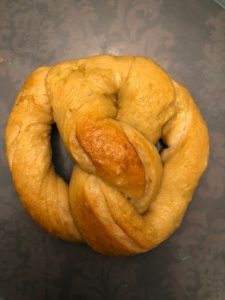 Big soft pretzels were time-consuming, but they came out tasting like those buttery mall pretzels. They were even good reheated the next day in the oven, but because of the painstaking process, “I don’t think I would make them again.”
Big soft pretzels were time-consuming, but they came out tasting like those buttery mall pretzels. They were even good reheated the next day in the oven, but because of the painstaking process, “I don’t think I would make them again.”
On the downside, smoky cheddar-crusted cornish pasties were “a bit dry” and needed a side of ketchup for dunking. But the pastry was interesting, as it used a bit of vinegar for tenderizing. Blue cheese and scallion cornbread was also dry and “you couldn’t taste the cheese,” a flaw that also appeared (despite using extra-sharp cheddar) in the brewers’ cheddar bread. Brown Irish soda bread was an unmitigated flop: “it was dense, heavy, and didn’t taste good.”
It should be obvious by now that we went all-in, approaching our baking with gusto. But for most, this title just didn’t make the grade. As I reviewed everyone’s comments, it seemed that the majority had a fairly successful experience; but somehow we weren’t too impressed. Part of this may be due to the style of the recipes, and for some the problem was the quantities. Almost all of the recipes make a decent-sized batch; and as we learned in September, most of us live in smaller households. So, too much of a pretty good thing? And, of course, several in the group mentioned that they are not bakers; so it’s an uphill battle from the get-go.
Interestingly, this book made quite a splash when it was published in early 2019, earning rave reviews and gushing quotes from notable bakers and authors. It’s been widely praised for its homespun and user-friendly recipes, as well as its practical, no-fuss approach. The author’s tone is friendly and chatty; she’s clearly passionate about her Midwestern roots, and the diversity to be found in an area many coastal types see as characterless. Ms. Sever may have wowed the critics, but unfortunately she didn’t win us over: our voting averaged out to a 2.1, our lowest score in a long time.
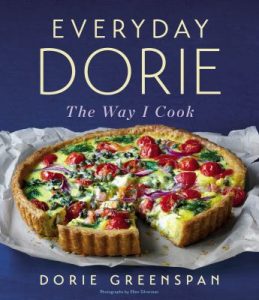 Our next meeting will be on Friday, January 29 at 11 AM. We’ll chat via Zoom; if you aren’t already on our mailing list and would like to attend, please email group leader Andrea Grant. We’ll be cooking, and maybe not baking, this month from Dorie Greenspan’s Everyday Dorie. Copies are available at the main circulation desk.
Our next meeting will be on Friday, January 29 at 11 AM. We’ll chat via Zoom; if you aren’t already on our mailing list and would like to attend, please email group leader Andrea Grant. We’ll be cooking, and maybe not baking, this month from Dorie Greenspan’s Everyday Dorie. Copies are available at the main circulation desk.
Happy New Year to all!






